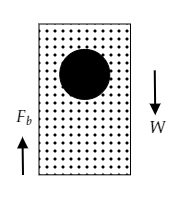
The apparent weight of the body in a liquid is
A)
B)
C)
D) None of these.
Answer
506.7k+ views
Hint:Whenever a body is submerged partially or fully in a liquid it experiences an upthrust. The weight of the body is felt to decrease under the action of the upthrust. Archimedes’ principle gives the apparent weight of the body to be equal to the difference between the weight of the body and the upthrust experienced by it.
Formulas used:
-The apparent weight of a body in a liquid is given by,
-The weight of a body is given by,
-The upthrust on a body by a liquid is given by,
Complete step by step answer.
Step 1: Sketch a figure representing a body in liquid.

The above figure depicts a body immersed in some liquid. (It can be partially or fully immersed)
The force of buoyancy or upthrust
Let
Step 2: Based on Archimedes’ principle, express the apparent weight of the body.
The weight of the body can be expressed as
The upthrust experienced by the body can be expressed as
According to Archimedes’ principle, the upthrust acting on the body will be equal to the weight of the body. So the difference between the weight and the upthrust will correspond to the apparent weight of the body.
i.e.,
Substituting equations (1) and (2) in (3) we get,
So the correct option is A.
Note: The volume of the liquid displaced on immersing the body will be equal to the volume of the body. The mass of an object is expressed as
Formulas used:
-The apparent weight of a body in a liquid is given by,
-The weight of a body is given by,
-The upthrust on a body by a liquid is given by,
Complete step by step answer.
Step 1: Sketch a figure representing a body in liquid.

The above figure depicts a body immersed in some liquid. (It can be partially or fully immersed)
The force of buoyancy or upthrust
Let
Step 2: Based on Archimedes’ principle, express the apparent weight of the body.
The weight of the body can be expressed as
The upthrust experienced by the body can be expressed as
According to Archimedes’ principle, the upthrust acting on the body will be equal to the weight of the body. So the difference between the weight and the upthrust will correspond to the apparent weight of the body.
i.e.,
Substituting equations (1) and (2) in (3) we get,
So the correct option is A.
Note: The volume of the liquid displaced on immersing the body will be equal to the volume of the body. The mass of an object is expressed as
Recently Updated Pages
Master Class 12 Economics: Engaging Questions & Answers for Success

Master Class 12 Maths: Engaging Questions & Answers for Success

Master Class 12 Biology: Engaging Questions & Answers for Success

Master Class 12 Physics: Engaging Questions & Answers for Success

Master Class 12 Business Studies: Engaging Questions & Answers for Success

Master Class 12 English: Engaging Questions & Answers for Success

Trending doubts
Which one of the following is a true fish A Jellyfish class 12 biology CBSE

What is the Full Form of PVC, PET, HDPE, LDPE, PP and PS ?

What are saprophytes Give two examples class 12 biology CBSE

How do you convert from joules to electron volts class 12 physics CBSE

Mirage is a phenomena due to A Refraction of light class 12 physics CBSE

Why did French artist Frederic sorrieu prepare a series class 12 social science CBSE




